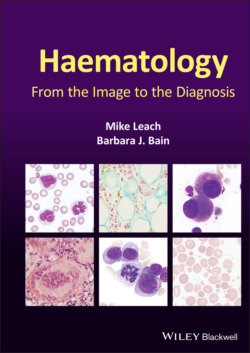Читать книгу Haematology - Barbara J. Bain, Irene Roberts - Страница 11
Оглавление2 Bone marrow AL amyloidosis
A 47‐year‐old man presented with peripheral oedema due to nephrotic syndrome and a kidney biopsy was planned. Full blood count showed Hb 154 g/l, WBC 7.8 × 109/l and platelets 355 × 109/l. Serum creatinine was 136 μmol/l, estimated glomerular filtration rate (eGFR) 49 ml/min/1.73 m2, albumin 17 g/l and urine protein 5.4 g/l. A serum IgA lambda paraprotein (9 g/l) and excess serum free lambda light chains at 103.5 mg/l (NR 5.7–26.3) were identified.
A bone marrow aspirate identified deposits of amorphous, purple‐staining material suggestive of amyloid protein (top left image) (all images ×50 objective). The trephine biopsy sections showed diffuse eosinophilic amorphous material (top right, H&E) in keeping with amyloid deposited around fat cells, around erythroid islands, in the walls of small vessels and throughout the interstitium. Immunohistochemistry for CD138 revealed 7% plasma cells with non‐specific binding to the amyloid deposits (bottom left, immunoperoxidase) the latter deposits staining also with Sirius red (bottom right). These findings are indicative of extensive bone marrow amyloid deposition due to primary AL amyloidosis. In view of these findings the renal biopsy was now not deemed necessary.
This case illustrates the striking morphological abnormalities encountered in amyloidosis; accurate recognition of these features is important in bringing together a unified clinical diagnosis.
A second patient presented with back pain and vertebral collapse. MRI suggested a marrow infiltrative disease such as myeloma. Indeed, he was shown to have raised serum free lambda light chains (367 mg/l) but no paraprotein was detected. The bone marrow aspirate, however, was hypocellular and showed low level (<1%) involvement by plasma cells so the diagnosis was questioned. The trephine biopsy sections showed heavy involvement by AL amyloidosis (all images below, H&E, left ×10, centre and right ×50) occupying well over 80% of the marrow space, with notable involvement of vessel walls. In the cellular areas well over 90% of cells were neoplastic plasma cells. Elsewhere small pockets of malignant plasma cells were identified (below centre). Extensive bone marrow amyloidosis can influence accurate assessment of plasma cell populations and can delay accurate diagnosis.
MCQ
1 Amyloid in tissue sections can be identified by positive staining with:Congo redMartius scarlet blueMethenamine silverPrussian blueSirius redFor answers and discussion, see page 206.
